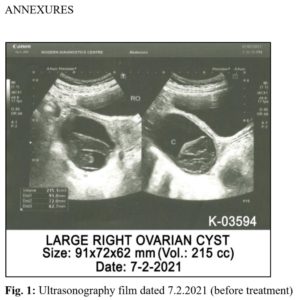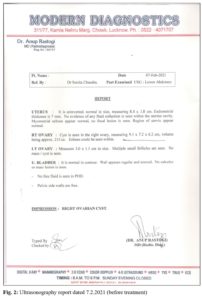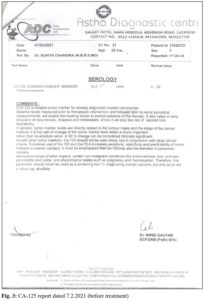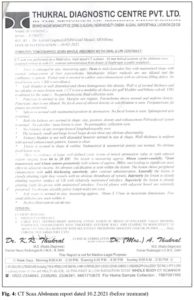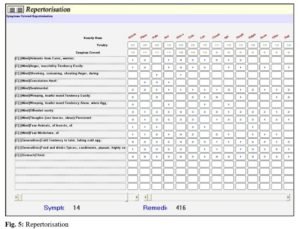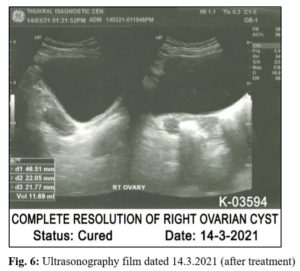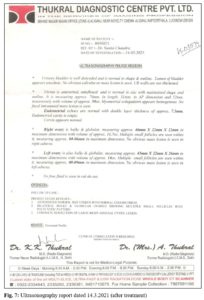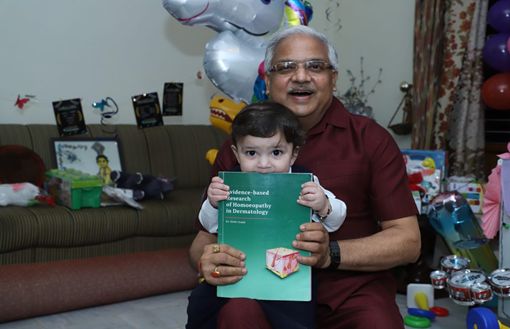Author of the article is Dr. Girish Gupta, MD (Hom), PhD Chief Consultant Physician at GAURANG CLINIC AND CENTRE FOR HOMOEOPATHIC RESEARCH, India
ABSTRACT
Patients of large ovarian cyst which do not respond to hormone therapy may require surgical intervention. It should, however, be the last choice especially in unmarried and childless women. A successfully treated case of large ovarian cyst is presented here to acquaint the homoeopathic physicians about the power of homoeopathic medicine selected on holistic basis.
KEYWORDS
Homoeopathy, ovarian cyst, ultrasonography, constitutional medicine, holistic, Natrum muriaticum
INTRODUCTION
Ovarian cysts are fluid filled sac in the ovary. These may occur at any age from menarche to menopause. Most of the cases remain asymptomatic. However, in few cases menstrual irregularities, dyspareunia, abdominal bloating, lower backache, tenderness of breast, nausea and vomiting may be the presenting symptoms. Ovarian cysts are mostly benign and their malignant transformation is rare.1 A significant number of cysts regress spontaneously2 thus immediate surgery should be avoided as much as possible in unmarried and childless women where preservation of reproductive functions is prime concern. Hormone therapy/ use of the oral contraceptive pill is also not always helpful in resolution of the cyst.3
Homoeopathic medicines when prescribed after individualization considering psychological factors in selection of the remedy on the principle of similia, strike at the root cause, acting through psychophysical axis leading to reversal of hormonal imbalance and regression of ovarian cyst. Ultrasonography (USG) is well accepted as a fast and non-invasive first choice of examination to evaluate ovarian lesions.4 However, it has limited inter observer variability.5 There are umpteen number of cases of ovarian cyst resolved by homoeopathic medicines along with many mega studies on the subject. Williamson et. al.6 and Gupta et. al.7-11 has also published clinical research papers and case reports validating the role of homoeopathic medicines in cases of ovarian cyst. The main objective to publish this case is to demonstrate the efficacy of constitutional homoeopathic medicine, Natrum muriaticum, in resolution of large ovarian cyst in very short duration of thirty-four days only.
Case history
A 21-year-old, unmarried girl, Miss KP (K-03594) reported on 10.2.2021 for treatment of large right ovarian cyst measuring 9.1 x 7.2 x 6.2 cm. Her menses were irregularly irregular usually delayed, painful, profuse, lasting 5 days with phases of amenorrhoea. (LMP-7.2.21). Her CA-125 was within normal limit. She consulted a gynaecologist who advised immediate surgery due to large size of the cyst. Even after repeated counselling by us that surgery is a better option, her parents wanted a trial of treatment because the girl was unmarried. To be doubly sure about the size and nature of the cyst, a CT scan of abdomen was advised which corroborated the findings of ultrasound.
Initial investigations
Ultrasonography of Abdomen (7.2.2021)
A large cyst seen in right ovary measuring 9.1 x 7.2 x 6.2 cm (vol.: 215 cc), echoes could be seen within. (Fig. 1, 2)
Blood (7.2.21)
CA-125: 10 U/ml (Fig. 3)
CT Scan Abdomen (10.2.2021)
Large well-defined right adnexal cystic lesion of mixed attenuation measuring 88 x 72 x 61 mm (vol.: 202 cc) showing peripheral enhancement with thickened anterior wall leading to mass effect to adjacent viscera. (Fig. 4)
Life space
The girl was very much attached to her grandmother who was severely ill and bed ridden. She used to help her mother in daily chores apart from taking care of her grandmother who expired in August 2020. She was teaching in a private school but was upset due to tremendous work pressure and less remuneration. She was not satisfied with the job and finally resigned in September 2020.
She had tendency to catch cold, increased thirst and desire for spicy food. She also revealed fear of insects and misfortune. She was sentimental, used to weep when alone, get offended and angered when provoked.
Past history
She had Koch’s abdomen for which ATT was given for 9 months in 2019.
Totality of symptoms
- Ailments from cares and worries
- Anger easily
- Shrieking during anger
- Amelioration from consolation
- Sentimental
- Weeping easily
- Weeping when alone
- Offended easily
- Persistent thoughts
- Fear of insects
- Fear of misfortune
- Tendency to catch cold
- Desire for spicy food
- Thirst increased
Remedy Selection (Repertorial method)
- Selection of Repertory
Complete repertory was used for repertorisation by ‘Hompath Classic’ software (Version 8.0) of Mind Technologies Private Limited, Mumbai.
- Repertorial totality
- [Mind]Ailments from: Cares, worries:
- [Mind]Anger, irascibility: Tendency: Easily
- [Mind]Shrieking, screaming, shouting: Anger, during:
- [Mind]Consolation: Amel.:
- [Mind]Sentimental
- [Mind]Weeping, tearful mood: Tendency: Easily:
- [Mind]Weeping, tearful mood: Tendency: Alone, when: Agg.:
- [Mind]Offended easily:
- [Mind]Thoughts (see fancies, ideas): Persistent:
- [Mind]Fear: Animals, of: Insects, of:
- [Mind]Fear: Misfortune, of:
- [Generalities]Cold: Tendency to take, taking cold agg.:
- [Generalities]Food and drinks: Spices, condiments, piquant, highly
- [Stomach]Thirst
- Repertorisation
Repertorisation sheet is enclosed. (Fig. 5)
- Repertorial analysis
After repertorization, the following medicines were identified for differentiation
| Medicine | Marks secured | Rubrics covered |
| Natrum muriaticum | 22 | 12 |
| Phosphorus | 20 | 11 |
| Pulsatilla | 20 | 11 |
| Arsenicum album | 18 | 11 |
| Nux vomica | 23 | 10 |
| Calcarea carbonica | 22 | 10 |
| Lycopodium | 16 | 10 |
On repertorial analysis, it was found that Natrum muriaticum covered all important rubrics, i.e., 12 out of 14. As regards total marks secured the medicines were: Natrum muriaticum (22), Phosphorus (20), Pulsatilla (20), Arsenicum album (18), Nux vomica (23), Calcarea carbonica (22), and Lycopodium (16). As per the concept of repertorial analysis, more weightage is to be given to the medicines covering more number of rubrics than total marks obtained hence Nux vomica and Calcarea carbonica were ruled out.
Justifications of prescription
Natrum muriaticum was selected as the similimum on the basis of repertorial analysis and in consultation with Materia Medica considering the totality of characteristics mental symptoms, physical generalities.
First prescription (February 10, 2021)
Natrum muriaticum 30 single dose once a week followed by Placebo x 4 weeks.
Follow- up (March 14, 2021)
Menses appeared on 11.3.21, flow normal.
A repeat ultrasound was advised to see if there was any change in the size of cyst.
Ultrasonography of Pelvis (14.3.2021)
Complete resolution of right ovarian cyst. (Fig. 6, 7)
The patient although asymptomatic is still under observation.
DISCUSSION
There is no “disease specific” remedy for ovarian cyst in homoeopathy. Instead each prescription is unique and designed according to the individual case because every patient differs from the other having same disease. A constitutional remedy thus selected works through psycho-neuro-endocrine axis leading to reversal of pathological changes in the ovaries.
The case presented here also supports the action of Natrum muriaticum (38.8%) seen in previously published clinical study.10 It also supports the hypothesis drawn for the study that individualized homoeopathic medicines are useful in treatment of ovarian cysts. Thus it is important that patients with ovarian cysts need to be assessed on mental and physical aspects including causation for better prescription.
CONCLUSION
The case reported here shows the effectiveness of individualized homoeopathic medicine in the treatment of ovarian cyst prescribed as per principles of Homoeopathy. The message by reporting this case is to inculcate confidence in homoeopathic physicians to have firm belief in homoeopathic philosophy to tackle such difficult cases instead of resorting to disease specific patents being sold in the market with the label of homoeopathic medicine.
CONFLICT OF INTEREST
There are no conflicts of interest.
REFERENCES
- Crayford TJB, Campbell S, Bourne TH, Rawson HJ, Collins WP. Benign ovarian cysts and ovarian cancer: A cohort study with implications for screening. Lancet 2000; 355: 1060-3.
- Ekerhovd E, Wienerroith H, Staudach A, Granberg S. Preoperative assessment of unilocular adnexal cysts by transvaginal ultrasonography: A comparison between ultrasonographic morphologic imaging and histopathologic diagnosis. Am J Obstet Gynecol 2001; 184: 48-54.
- Grimes DA, Jones LB., Lopez LM, Schulz KF. Oral contraceptives for functional ovarian cysts. Cochrane Database of Systematic Reviews 2009, Issue 2. Art. No.: CD006134. DOI: 10.1002/14651858.CD006134.pub3
- Okai T, Kobayashi K, Ryo E, et al. Transvaginal sonographic appearance of hemorrhagic functional ovarian cysts and their spontaneous regression. Int J Gynecol Obstet 1994; 44: 47–52.
- Higgins RV, van Nagell JR, Woods CH, Thompson EA, Kryscio RJ. Interobserver variation in ovarian measurements using transvaginal sonography. Gynecol Oncol 1990; 39: 69–71.
- Williamson et. al, Homoeopathic treatment of Ovarian Cysts-a series of 40 cases, British Homoeopathic Journal 1991; 80:143-8.
- Gupta G. A clinical study on cases of pelvic tumours in response to homoeopathic treatment assessed by ultrasonography. Asian Homoeopathic Journal, Apr.-Jun. 1995; 5 (2): 15-23.
- Gupta G, Gupta N, Singh V, Singh R. Ultrasonographic follow-up of ovarian cyst cases in response to homoeopathic treatment: A clinical study. Homoeopathy for All, April 2003: 39-45.
- Gupta G, Gupta N, Singh R. Evidence based clinical study on the role of homoeopathic drugs in case of ovarian cyst. Asian Journal of Homoeopathy, May 2008: 22-33.
- Gupta G, Singh N, Singh R, Singh S, Nayak C, Khurana A. Evidence based clinical study on the effect of homoeopathic medicines in cases of ovarian cysts. Indian Journal of Research in Homoeopathy, January-March 2011; 5 (1): 36-42.
- Gupta G. A case of bilateral adnexal cyst cured by Natrum muriaticum. Advancement in Homoeopathic Research, November 2019-January 2020: 29-31.
